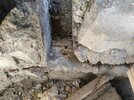- Joined
- 23 Nov 2017
- Messages
- 32
- Reaction score
- 1
- Country

We recently noticed that some of our floor joists are very rotten at one end - the outside wall. The ground level outside is approximately level with the floor level inside and earth sits up against the sandstone wall causing moisture to filter through the wall and into the joists. Also, the void under the floor has had rubble and stones dumped into it, sometimes encasing the joists. Wherever the rubble has touched the joists they're rotten. Also, wherever the joists touch the walls they're rotten - there doesn't seem to be a damp proof layer/membrane - they seem to be sitting on wooden supports within the walls. There's also a central supporting joist which is also heavily rotten at one end which will be getting repaired. This has all been like this for 30-50+ years, maybe more. The house was built approx 1890.
We've now removed the floor and noticed that the joists at the other side are also rotten only where they're recessed into the internal wall. Until then my plan had been to sister the severely damaged end and lay a new concrete footing just inside the external wall to support them. The external sandstone wall is noticeably wet and could take months/years to dry hence the new foundation. Now that we've noticed the other end is also rotten, wondering whether to sister both ends or simply replace the joists? We could also potentially put a new footing for that end too. Advice much appreciated.
The room is approx 5m wide and the joists are 160mm x 65mm. I assume they're original.
I'm also intending to:
1. Dig out all of the rubble
2. Dig out a border around the external wall and infill with stones
3. Fit a breathable membrane, wood fibre insulation and vapour control membrane as per this article.
Left hand side is external wall.

Some joists almost entirely rotten so will need at least 1m replaced.

This is the internal wall side and it's really only the amount recessed into the wall that's rotten.

We've now removed the floor and noticed that the joists at the other side are also rotten only where they're recessed into the internal wall. Until then my plan had been to sister the severely damaged end and lay a new concrete footing just inside the external wall to support them. The external sandstone wall is noticeably wet and could take months/years to dry hence the new foundation. Now that we've noticed the other end is also rotten, wondering whether to sister both ends or simply replace the joists? We could also potentially put a new footing for that end too. Advice much appreciated.
The room is approx 5m wide and the joists are 160mm x 65mm. I assume they're original.
I'm also intending to:
1. Dig out all of the rubble
2. Dig out a border around the external wall and infill with stones
3. Fit a breathable membrane, wood fibre insulation and vapour control membrane as per this article.
Left hand side is external wall.
Some joists almost entirely rotten so will need at least 1m replaced.
This is the internal wall side and it's really only the amount recessed into the wall that's rotten.

